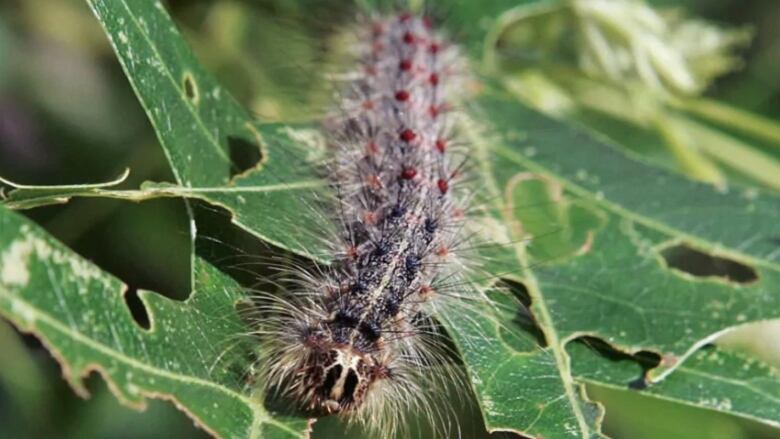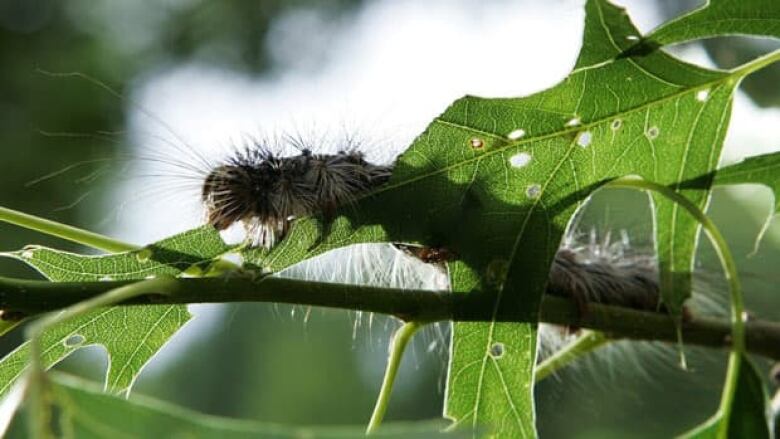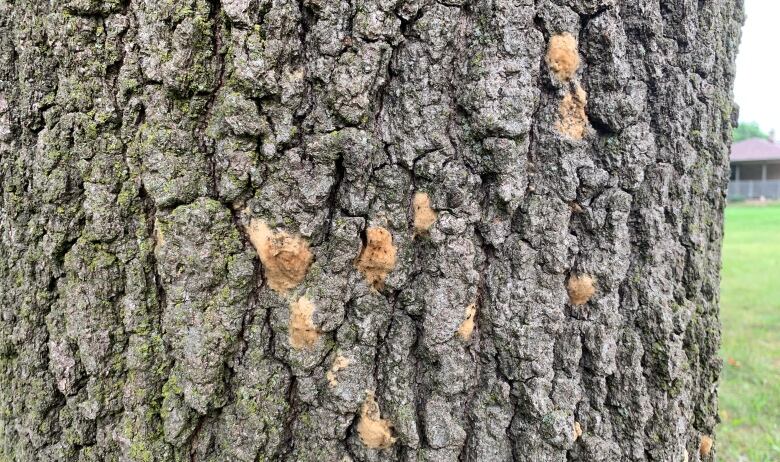Gypsy moth caterpillars 'devastate' trees in Hamilton, but city isn't spraying
Glanbrook, Flamborough councillors say 'thousands' are falling from trees, causing rashes

Gypsy moth caterpillars are feasting on the leaves of trees in Hamilton, but city staff say they won't be coming forward with recommendations on how to deal with the problem until 2022.
Sam Scarlett, city manager of forestry and horticulture, said in Wednesday's city council meeting that Hamilton is only doing ground-spraying for the invasive species in select locations this year, as well as burlap banding some trees.
The city also doesn't target private property.
"This is really detrimental," said Ward 11 councillor Brenda Johnson, noting that Glanbrook has been inundated with the pests.
"It's becoming almost epidemic."
'Thousands' of caterpillars
Johnson said people are getting rashes from the amount of caterpillars dropping from the trees in their backyards.
"This is not something that's[a] cute little caterpillar that's crawling around your yard.It's everywhere," she said.
"Trust me, if it's going rampant through the ruralarea, it will eventually get into the urban area."
Ward 15 councillor Judi Partridge said there are "thousands" of caterpillars onproperties in Flamborough, including Carlisle. She also said people are getting welts and hives.
"If you're walking under a tree, you will have probably about 30 of them land on you just like that," she said. "They do devastate the trees."
Royal Botanical Gardens, Burlington spraying
Gypsy moths, which were first detected in the province in 1969, can be found across southern Ontario as far north as Sault Ste. Marie.Their eggs hatch in the spring and the larvae feed on tree foliage.
According to the city, feeding normally finishes byearly to mid-July. Damage to the trees depend on several factors, but the trees can die if they're alsodealing with hot, dry summers or other pests.

Scarlett said last winter's data showed "very isolated pockets" of infestation in Hamilton. He believes the weather conditions over the past couple of weeks have increased the growth and hatch rate.
Scientists told CBC Ottawa that 2021 is shaping up to be abumper year.
Brant County, the City of Sarnia, City of London andnearby City of Burlington, which shares a border with Flamborough, are among some municipalities that sprayed for the species this year.
Scarlett said Burlington was spraying a "small" number of parks and woodlot areas.
Between May 24 and June 4, the Royal Botanical Gardens is having a helicopter apply four aerial sprays ofbio-pesticide Btk to Rock Chapel and Cootes Paradise south shore in order to mitigate an outbreak.
The City of Hamilton most recently sprayed about2,600 hectares of city and private land in 2018/2019, he said.The time before that was in 2008.
While city-owned trees innaturalized areas and woodlots are specifically targeted, he said, the spray can be applied by helicopter, meaning private land can get hit too.
"The goal of that spray is to not eradicate gypsy moth, but it's really to knock that peak of that population off and to control the numbers," he said.
Report coming in 2022
He said the Hamilton Conservation Authority has been scraping and banding trees with burlap on their property this year. The Grand River Conservation Authority has sprayed, but only on their lands.
An aerial application over woodlots requires permits from the Ministry of Transportation, Scarlett said, which take several months.
He said people should report high infestations this year to the city, as staff collect data over the fall and winter.

Scarlett said staff will present a report to the city's public works committee on how and where to control the gypsy moths in the first quarter of 2022.
He noted there are natural controls on the populations, which peak every eight to ten years before naturally declining. When the population reaches a certain level, he said, a virus and fungus affect the moths.
"We are keeping a really keen eye on that natural population collapse as well," he said.
There are tips for homeowners looking to control the moths, such as banding their own trees,on the city's website.












_(720p).jpg)


 OFFICIAL HD MUSIC VIDEO.jpg)
.jpg)



























































































